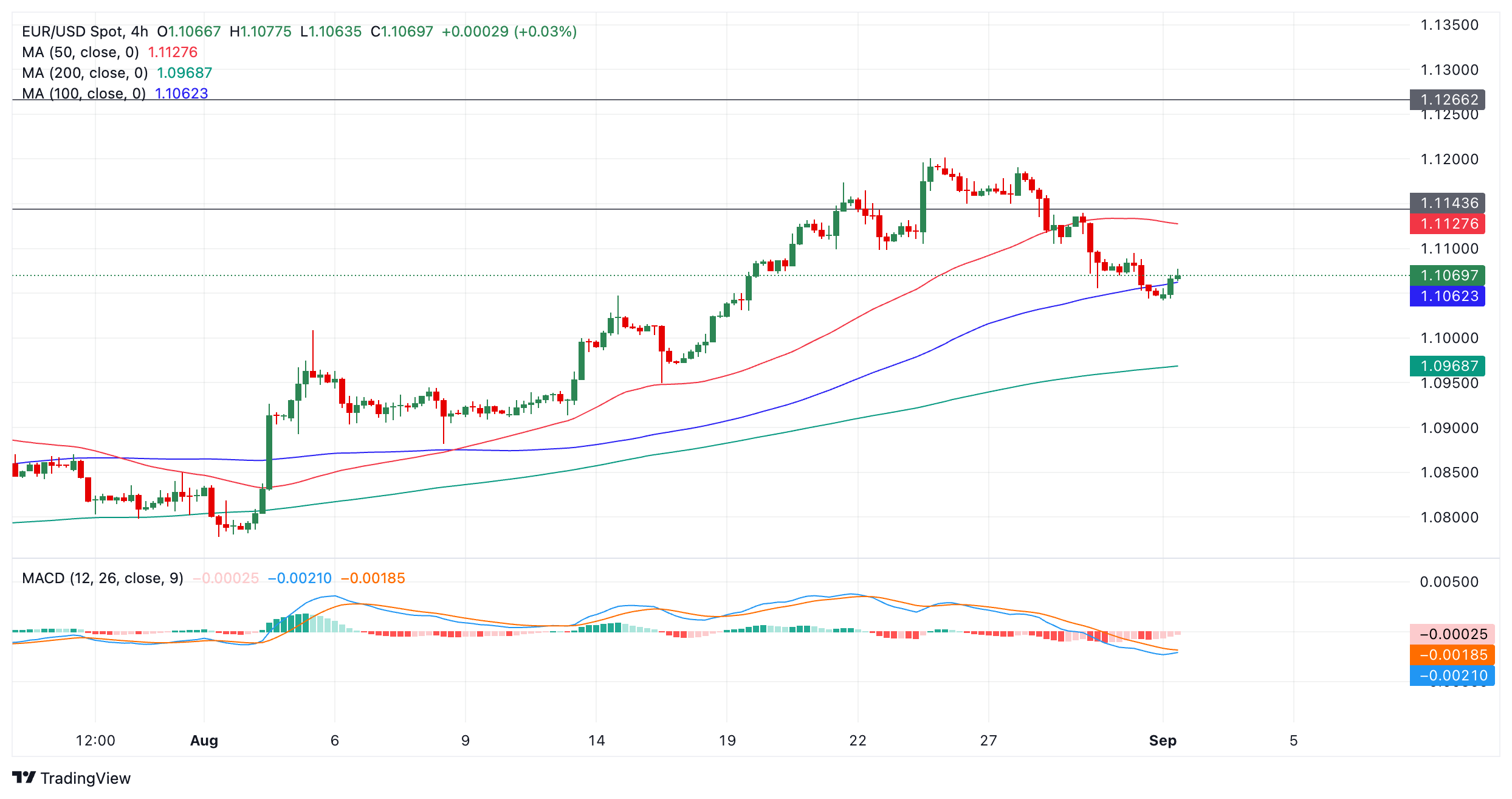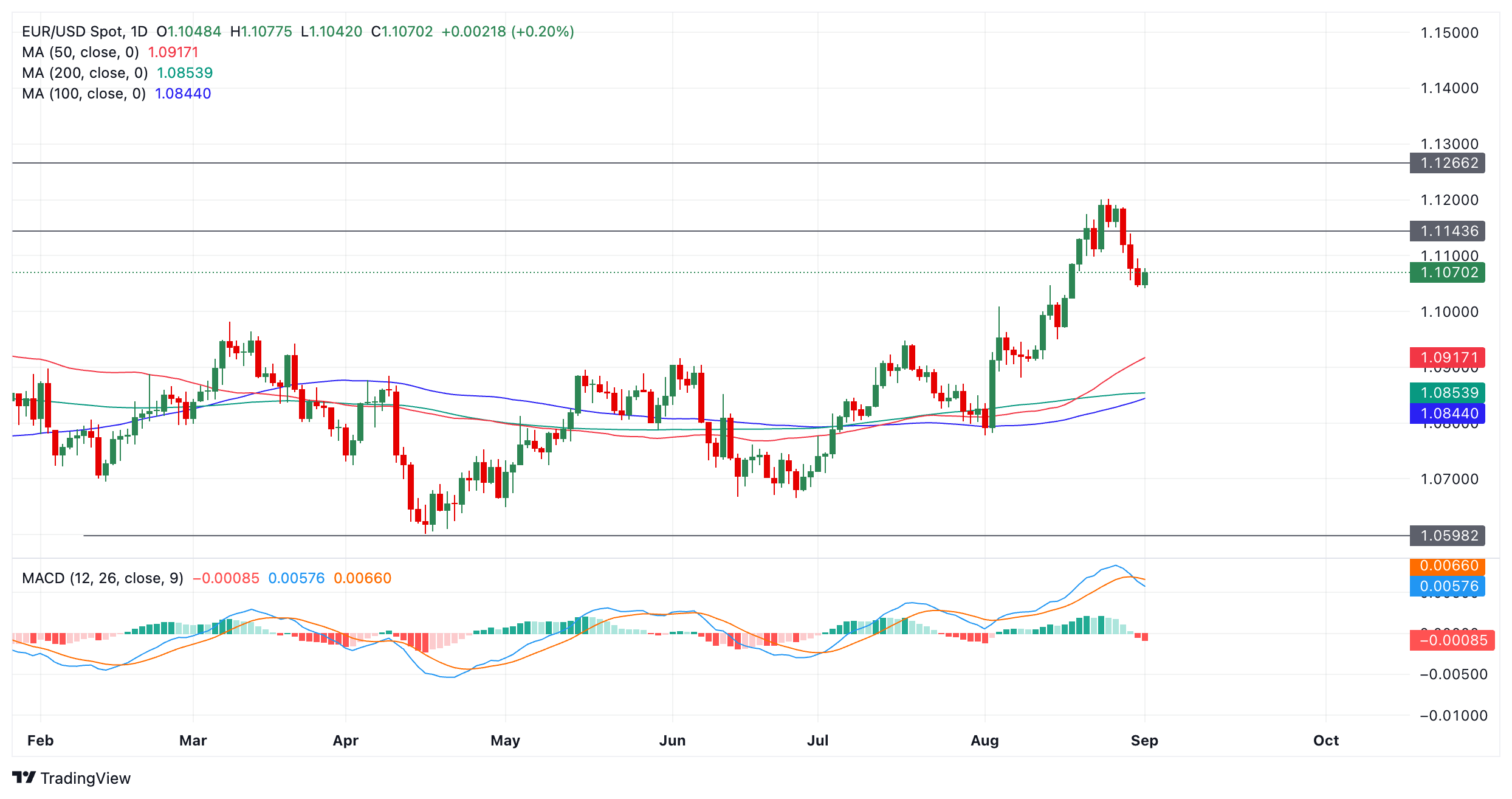- Phân tích
- Tin tức và các công cụ
- Tin tức thị trường
- EUR/USD rises on persistence of doubt about US economy
EUR/USD rises on persistence of doubt about US economy
- EUR/USD rises as investors continue to price in the possibility the US economy may be slowing rapidly.
- The chances remain high that the Federal Reserve might have to make steep cuts to interest rates, weighing on the USD.
- The Euro gains support as interest rates in the Eurozone could stay higher for longer due to persistent wage inflation.
EUR/USD trades higher by about a quarter of a percent in the 1.1070s on Monday, as the Euro (EUR) strengthens against the US Dollar (USD) on the back of still-high probabilities the Federal Reserve (Fed) could implement a sharp cut in interest rates at their September meeting. This, in turn, weighs on the USD because lower interest rates make it less attractive to foreign investors, lowering capital inflows.
EUR/USD mildly higher on survival of chances of half-a-percent rate cut
EUR/USD edges higher as traders attempt to assess the future path of interest rates in the US. The probability that the Fed could cut the fed funds rate by 0.50% – to a range between 4.75% and 5.00% – at their September 18 meeting remains above 30% whilst the chances of a 0.25% reduction is fully priced in, according to the CME FedWatch Tool. The still fairly high chance of a 0.50% “mega cut” remains a headwind for the Greenback and supports EUR/USD.
US inflation data out on Friday showed the Personal Consumption Expenditures (PCE) Price Index remained unchanged at 2.5% in July, with core PCE still at 2.6%. Expectations had been for them both to rise a basis point. The data might have slightly eased concerns the US economy could be heading for a hard landing. Still, it will not be until US employment data comes out this week that investors will have all the “test results in for the patient” and can confidently assess what the Fed is likely to do. Friday’s Nonfarm Payrolls data for August will be particularly key in this respect.
EUR/USD recovers after Eurozone inflation data keeps investors guessing
The previous week was volatile for the Euro. German and Spanish annualized preliminary Consumer Price Index (CPI) data for August showed on Thursday inflation falling lower than the previous month and missing expectations, and this initially caused some weakness in the single currency as investors started to price a steeper fall in interest rates. However, when Eurozone-wide data was released the day after – at 2.2% and 2.8% for core – although they fell, they met economists’ expectations, helping the Euro to recover.
The data failed to alter perceptions that the European Central Bank (ECB) will reduce interest rates in Europe at a steady and cautious pace, which contrasts with the still relatively high chance of a steeper rate-cut trajectory in the US.
“Headline inflation dropped to 2.2% y/y in August – the closest it has been to the ECB’s inflation target since 2021 – but risks remain: Wage growth remains high and will keep core inflation sticky for the rest of this year,” said on Friday Anders Svendson, Chief Analyst at Nordea Bank.
Wages in the Eurozone are expected to continue rising strongly in the second half of 2024 before easing in 2025-2026, said ECB Executive Board Member Philip Lane in a recent speech. In the short term, this is likely to put upside pressure on inflation which, in turn, is likely to keep the ECB cautious and data-dependent regarding interest rates – a supportive factor for EUR/USD.
Technical Analysis: EUR/USD rolls over into a short-term downtrend
EUR/USD has established a declining sequence of peaks and troughs since peaking at 1.1202 on August 26. This sequence probably indicates the pair is in a short-term downtrend and, since “the trend is your friend,” odds now probably favor lower prices to come.
EUR/USD 4-hour Chart
A break below 1.1040 would provide added confirmation of more downside, to a potential initial target at 1.1000, a psychological level of support.
Conversely, a close above 1.1100 would bring the short-term downtrend into doubt and suggest the possibility of higher prices.
EUR/USD Daily Chart
The daily chart shows that the Moving Average Convergence Divergence (MACD) momentum indicator has crossed below its signal line, further indicating the possibility a new down move is evolving.
EUR/USD Weekly Chart
The weekly chart shows a bearish Two-Bar reversal pattern formed at the recent August highs (shaded rectangle). These occur when a long green-up week is followed by a similar-length red-down week. The pattern is a reliable indication of a reversal in the trend. The fact it formed at the 200-week Simple Moving Average level adds further evidence of a possibility of a move lower developing.
Euro FAQs
The Euro is the currency for the 20 European Union countries that belong to the Eurozone. It is the second most heavily traded currency in the world behind the US Dollar. In 2022, it accounted for 31% of all foreign exchange transactions, with an average daily turnover of over $2.2 trillion a day. EUR/USD is the most heavily traded currency pair in the world, accounting for an estimated 30% off all transactions, followed by EUR/JPY (4%), EUR/GBP (3%) and EUR/AUD (2%).
The European Central Bank (ECB) in Frankfurt, Germany, is the reserve bank for the Eurozone. The ECB sets interest rates and manages monetary policy. The ECB’s primary mandate is to maintain price stability, which means either controlling inflation or stimulating growth. Its primary tool is the raising or lowering of interest rates. Relatively high interest rates – or the expectation of higher rates – will usually benefit the Euro and vice versa. The ECB Governing Council makes monetary policy decisions at meetings held eight times a year. Decisions are made by heads of the Eurozone national banks and six permanent members, including the President of the ECB, Christine Lagarde.
Eurozone inflation data, measured by the Harmonized Index of Consumer Prices (HICP), is an important econometric for the Euro. If inflation rises more than expected, especially if above the ECB’s 2% target, it obliges the ECB to raise interest rates to bring it back under control. Relatively high interest rates compared to its counterparts will usually benefit the Euro, as it makes the region more attractive as a place for global investors to park their money.
Data releases gauge the health of the economy and can impact on the Euro. Indicators such as GDP, Manufacturing and Services PMIs, employment, and consumer sentiment surveys can all influence the direction of the single currency. A strong economy is good for the Euro. Not only does it attract more foreign investment but it may encourage the ECB to put up interest rates, which will directly strengthen the Euro. Otherwise, if economic data is weak, the Euro is likely to fall. Economic data for the four largest economies in the euro area (Germany, France, Italy and Spain) are especially significant, as they account for 75% of the Eurozone’s economy.
Another significant data release for the Euro is the Trade Balance. This indicator measures the difference between what a country earns from its exports and what it spends on imports over a given period. If a country produces highly sought after exports then its currency will gain in value purely from the extra demand created from foreign buyers seeking to purchase these goods. Therefore, a positive net Trade Balance strengthens a currency and vice versa for a negative balance.
© 2000-2024. Bản quyền Teletrade.
Trang web này được quản lý bởi Teletrade D.J. LLC 2351 LLC 2022 (Euro House, Richmond Hill Road, Kingstown, VC0100, St. Vincent and the Grenadines).
Thông tin trên trang web không phải là cơ sở để đưa ra quyết định đầu tư và chỉ được cung cấp cho mục đích làm quen.
Giao dịch trên thị trường tài chính (đặc biệt là giao dịch sử dụng các công cụ biên) mở ra những cơ hội lớn và tạo điều kiện cho các nhà đầu tư sẵn sàng mạo hiểm để thu lợi nhuận, tuy nhiên nó mang trong mình nguy cơ rủi ro khá cao. Chính vì vậy trước khi tiến hành giao dịch cần phải xem xét mọi mặt vấn đề chấp nhận tiến hành giao dịch cụ thể xét theo quan điểm của nguồn lực tài chính sẵn có và mức độ am hiểu thị trường tài chính.
Sử dụng thông tin: sử dụng toàn bộ hay riêng biệt các dữ liệu trên trang web của công ty TeleTrade như một nguồn cung cấp thông tin nhất định. Việc sử dụng tư liệu từ trang web cần kèm theo liên kết đến trang teletrade.vn. Việc tự động thu thập số liệu cũng như thông tin từ trang web TeleTrade đều không được phép.
Xin vui lòng liên hệ với pr@teletrade.global nếu có câu hỏi.


















